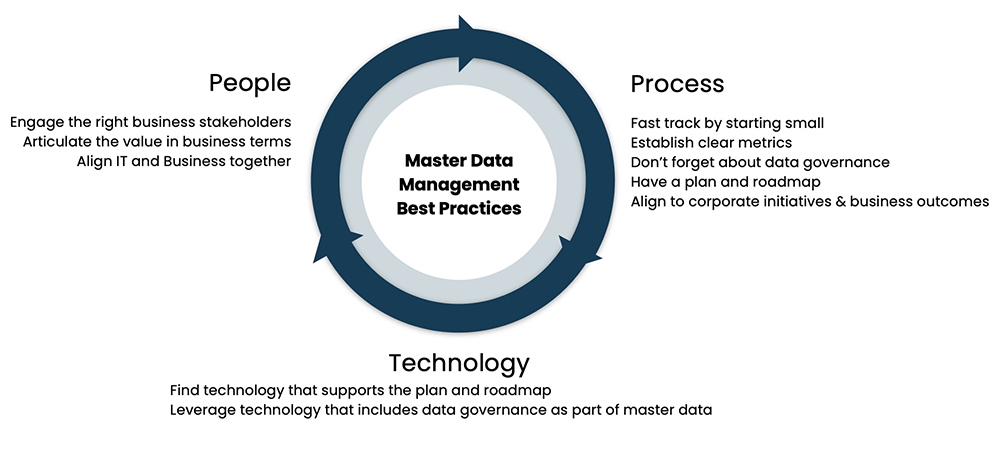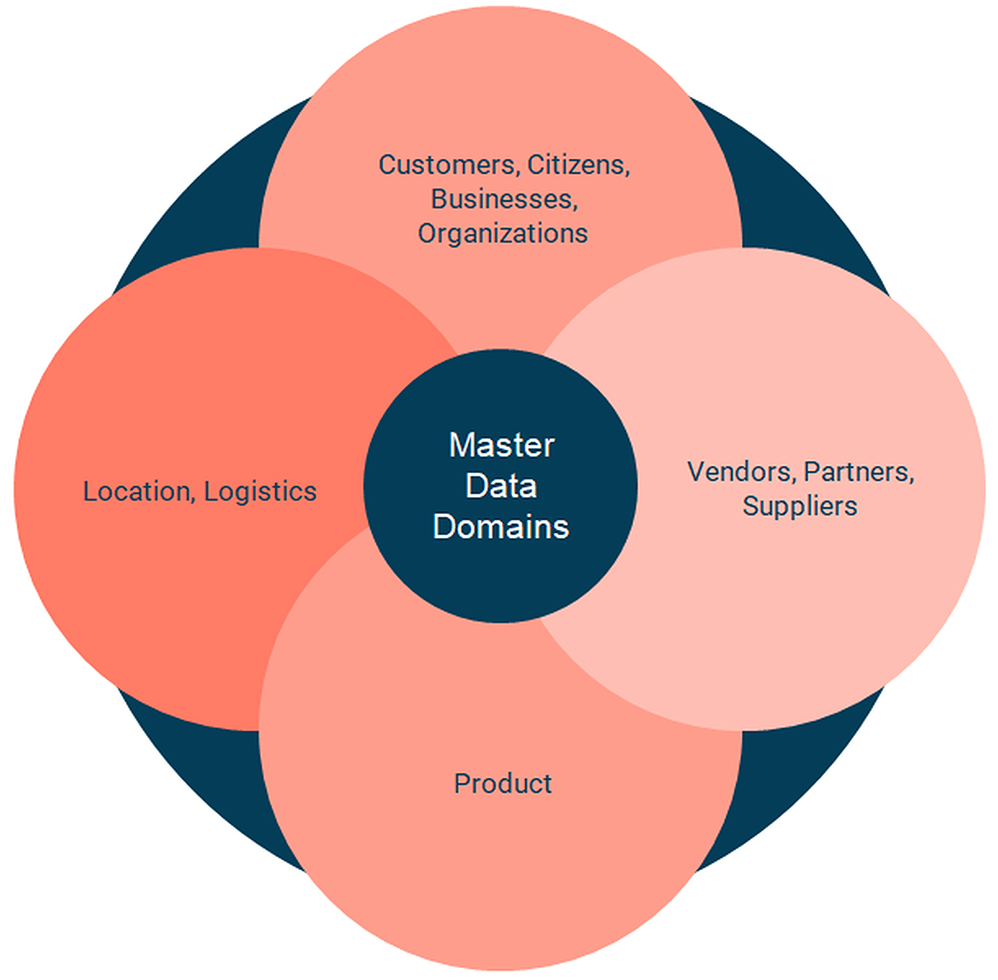At some point, many organizations say enough is enough. Fragmented and inconsistent data scattered across applications is undermining the business — and it won’t get better on its own.
That “bad data” has to be addressed if you’re going to achieve the data-driven business ideal that leadership is talking about. It’s time to get serious about master data management.
But how do you get started with MDM, and how do you maximize your payback? In this third post in a blog series, we outline best practices that leading organizations follow to ensure that data is consistent, accurate, timely, and trusted across the enterprise so that they can:
- Understand and delight customers
- Make informed business decisions
- Accelerate digital transformation and IT modernization
- Reduce the time and cost of manual data reconciliation
- Improve compliance with internal and external standards
Download our executive brief, “Trust or Bust: Why Trusted Master Data is Vital to Your Business,” for an overview of data challenges and solutions, and learn about the business risks of bad data in a companion blog post, “3 Ways That Bad Data Poses a Multimillion-Dollar Risk to Your Business.”
The Foundation: People, Process, and Technology
Even more so than some other initiatives, success with master data management depends on aligning people, processes, and technology with clear objectives.

People: Engaging business stakeholders, ideally with an executive sponsor, is especially important as business staff use data daily in operations and analytics.
Process: Establishing metrics, measuring before-and-after results, and ensuring ongoing data governance help create sustainable master data management.
Technology: Identify a solution that is easy to use, can be deployed quickly, interoperates with your tech stack, and uses innovative technology such as AI.
Four Best Practices for Master Data Management Success
Based on a people, process, and technology model, we’ve found that organizations using Boomi DataHub with the greatest success focus on four best practices:
1. Make a strong business case
A strong business case makes clear that master data management is not just an academic exercise, but a critical initiative geared to save time and money, make informed decisions, minimize risk, and improve experiences for customers, partners, and employees.
To get the full picture, be sure to solicit input from both IT and business stakeholders. The business impact angle is most likely to win funding — and ideally support from a C- or VP-level executive sponsor who can help guide change from the top down.
A master data business case might get started by IT professionals who identify challenges and opportunities in their hands-on data work. Other times, business user complaints over accessing data or repetitive swivel-chair data lookups can spark dialogue around master data management.
Whatever the impetus, a strong business case will:
- Identify data quality problem areas such as customers, forecasting, analytics, products, and supply chain. Outline business user challenges in accessing and reconciling bad data; anecdotes can “tell a story” that highlights problems.
- Estimate quantified impacts of bad data. If you’ve got three business users spending 15 hours a week wrangling data, that might amount to a $100,000 annual cost, depending on salaries. Financial impact can also be estimated in areas such as lost revenue from mistargeted cross-sell, high call center inquiries because of invoice discrepancies, or high turnover among staff tired of manual data work.
- Research and document successes that organizations similar to yours have realized with master data management to reinforce that your initiative is achievable and will deliver ROI.
2. Create a strategic master data roadmap
With your business case approved, it’s time to build out a strategic roadmap to launch and evolve your master data program. A collaborative approach between IT and business stakeholders lets you size up the relative difficulty of MDM in a given area versus the benefits expected.
Some guiding principles that successful customers follow include:

- Assess your top focus areas for MDM based on stakeholder input. In which areas is “bad data” hurting you the most? It could be in customer experiences, business decisions based on guesswork rather than trusted data, or staff inefficiency from endless data lookup and reconciliation chores.
- Build out your initial business case metrics to cover both bad data impacts and MDM benefits. Estimate a range of target outcomes, for example, eliminating $300,000 to $500,000 worth of customer churn because you’ve created a single 360-degree view of customers, or eliminating $150,000 to $200,000 worth of manual data work each year with MDM automation.
- Prioritize quick wins in hot-button business areas. At the start, you want to avoid a “boil the ocean” approach to emphasize targeted projects that build stakeholder rapport, solidify workflows, and let you fine-tune your approach. Initial successes create confidence for sustainable MDM.
- Strategize how to extend MDM across multiple domains as the roadmap evolves. For example, maybe your MDM program focused first on generating a 360-degree customer view — what’s next? Many organizations extend MDM to additional domains such as logistics/supply chain, products, business partners, and human resources.
3. Select the best MDM technology for your needs
Years ago, MDM initiatives had a high failure rate. On-premises solutions used highly complex data models, required expensive professional services over many months, and lacked straightforward integration with source systems.
Modern solutions like Boomi DataHub have changed that. Recognized as a “Champion in Master Data Management” by Software Reviews, Boomi MDH generates “golden records” by reconciling data across disparate systems, then synchronizing that reconciled data back across systems to help ensure a single version of the truth.
As a cloud-native solution with low-code development, Boomi MDH can be deployed in weeks, versus the months often needed with a legacy MDM solution. Reusability simplifies rollout and usage across multiple domains as you expand MDM efforts.
Simplicity of deployment is one reason why MDH is the second step that many of Boomi’s approximately 20,000 customers take once they have deployed core Boomi integration services. MDH’s native interoperability with Boomi Flow (workflow automation), B2B/EDI Management, and API Management helps ensure extensibility across your full data environment.
In addition, transparency makes it easy for IT or business staff to manually reconcile exceptions highlighted by Boomi MDH. Ease of use makes Boomi accessible to tech-savvy business users, and Boomi uses generative AI to connect and integrate data, applications, processes, people, and things — creating business outcomes faster than ever before.
4. Apply data governance and measurement
Ongoing data governance is an imperative for long-term success. A data governance practice brings together business subject matter experts and IT professionals to define data standards, establish rules, and monitor compliance whenever data is accessed, transformed, synchronized, or shared.
Governance is ideally handled by data stewards, often tech-savvy business users or IT professionals with strong business knowledge, to track data usage, security, and accessibility to authorized users. For example, a data steward will ensure that payroll information is accessible only to select individuals.
Data stewards also play a role in resolving exceptions quarantined by your MDM technology. And they help ensure that as you bring a new application on board, it can be swiftly embedded into the MDM ecosystem to generate and consume data that’s accurate and timely.
Done right, data governance establishes guardrails that minimize risk, increase security especially with PII (personal identifiable information), and heighten accountability. It’s a must-have if you want to fully capitalize on data’s value to the business.
The Business Impact of Bad Data
Along with data governance, tracking the business impact of MDM initiatives is valuable to quantify benefits realized. It prepares you to address whether the business has achieved that $250,000 savings forecast in your strategic roadmap, and can help justify additional initiatives in other domains. Conversely, tracking also identifies where an effort has fallen short of target outcomes so that you can rectify weaknesses or revise objectives.
Data has never been more important to business success than it is in today’s digital age. The impact of “bad data” will only grow along with increasing data volumes and application diversity. The right combination of people, process, and technology in an MDM strategy can eliminate those issues and help you build a truly data-driven organization.
To learn more, download our executive brief, “Trust or Bust: Why Trusted Master Data is Vital to Your Business,” and visit our Boomi DataHub capability page.

